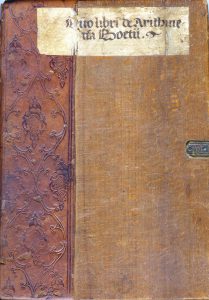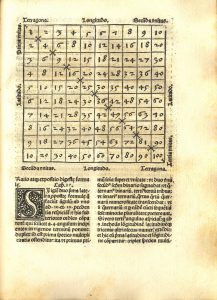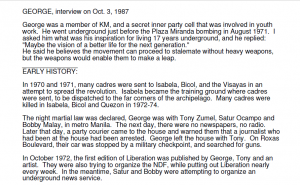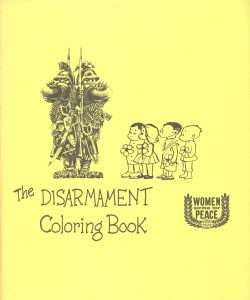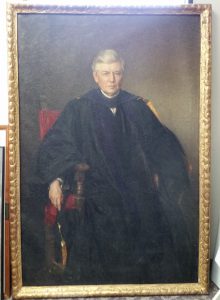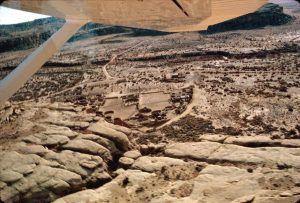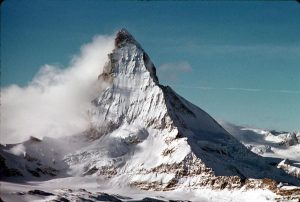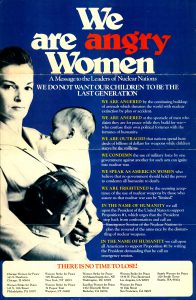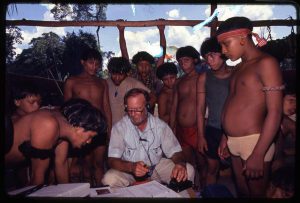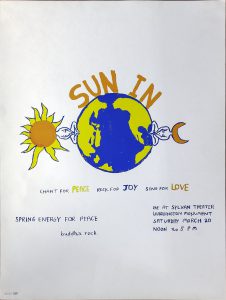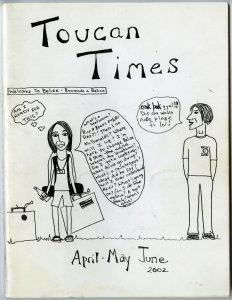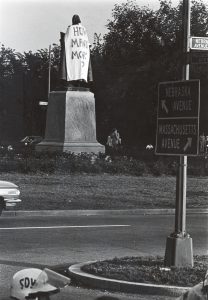AU Archives and Special Collections is pleased to announce its newest exhibit featuring woodblock prints of the Tōkaidō Road from the Charles Nelson Spinks Collection. It will be on display through the end of the summer at AU Archives on the second floor of the Spring Valley building. The images on display will rotate so feel free to drop by more than once.
Category Archives: Featured Collections
Staff Favorites in Special Collections
And for the final post celebrating our new home, we are going to talk about the stuff instead. Highlights from our rare book collection include 19th century American mathematics textbooks and Japanese wood block prints. Our manuscript collections document a variety of disciplines such as journalism and public service. Two of our most recent collecting initiatives relate to Peace Corps volunteers and social/political protest.
We polled staff members and asked them for their favorite items. Here are our top five:
Counter-inaugural demonstration image from the Frazier Collection. Leslie appreciated the costume and sign especially where it says “Hi Mom!”
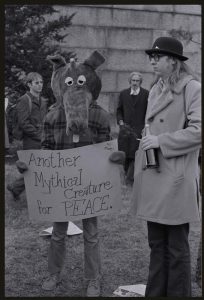
Protester in animal costume holding a protest sign at President Nixon’s second inauguration in 1973.
Arithmetica Boetij.Augsburg, Erhard Ratdolt, 20 May 1488. Susan noted that it is a wonderful resource for showing the components of a book with its leather cover and wooden boards. It includes the first use of a multiplication table.
Reporter Gregg Jones covered the People Power Revolution in the Philippines in 1986. He conducted interviews with members of the New People’s Army, including the founder of the Communist Party of the Philippines, Jose Maria Sison. Katie found intriguing Jones’ descriptions of the process of getting the interviews. Jones befriended NPA members and went for rides with them in rebel territory.
Women Strike for Peace created this coloring book to educate young people about the dangers of nuclear war. Susan found fascinating the concept of a coloring book with such dark images.
Nicaraguan market scene from Gentile Collection. Leslie liked the composition of this image which brings to life the wares and people at this market.
Out of the Vault – Painting of AU Chancellor John William Hamilton
This life size portrait by his brother, Edward Wilbur Dean Hamilton, shows Chancellor John William Hamilton in his academic regalia seated in a red velvet chair. Art critic William Howe Downs praised the painting in an article in the Boston Evening Transcript as follows: “this work…will take rank among Mr. Hamilton’s most important and perfect portraits of men.”
Retired Methodist Bishop John W. Hamilton (1845-1934) succeeded his brother, Franklin E. Hamilton (1866-1918), as Chancellor of American University in 1916. He served until 1922. Hamilton earned an A.B. from Mount Union College and a S.T.B. from the Boston University School of Theology. He was elected Corresponding Secretary of the Freedmen’s Aid and Southern Education Society in 1892. Hamilton was an advocate of temperance and the rights of African Americans and women.
Edward Wilbur Dean Hamilton (1864-1943), painted landscapes, portraits, and scenes of everyday life. He studied painting at the Massachusetts Normal Art School (1883), the Rhode Island College of Design, and Académie des Beaux-Arts in Paris (1889). Wilbur Hamilton exhibited paintings at the Paris Salon (1890-1892). After his return to America in 1892, he exhibited his landscapes and portraits in Atlanta, Boston, New York, Philadelphia and Washington, D.C. Critics admired Wilbur Hamilton’s work for its refinement and attention to detail. The World’s Columbian Exposition in Chicago in 1893 featured two of his landscapes. Wilbur Hamilton won a gold medal at the Panama Pacific Exposition in San Francisco in 1915. He taught at Massachusetts Normal Art School, Boston University, and the Rhode Island School of Design before starting the Jones River Art School. The Rhode Island School of Design and the Museum of Fine Arts, Boston have some of Wilbur Hamilton’s paintings.
Photographic Material and Other Art Work of Herbert E. Striner is now completely cataloged
AU Archives reached a milestone earlier this year when we finished cataloging the images in the Herbert E. Striner Collection. The over 9,000 negatives, prints, and slides display his interest in people and architecture. Striner’s passion for photography began at the end of World War II, when he received his first camera while waiting to return home from the China-Burma-India Theater. Striner regularly photographed his family and friends and his favorite places in the Washington, DC area including the National Cathedral and Glen Echo Park. Striner took his camera with him on his personal and professional travels depicting the people he met and the places he visited in Asia, the Caribbean and Europe. His camera captured buildings, flora and fauna, and people. He was fascinated by light and took multiple pictures of everything from mushrooms to Navajo elders Featured subjects include Islamic and Jewish sites in Washington, DC including the Embassy of Israel and the Islamic Center. Of note are images of the Chinese table-tennis delegation visit to the United States in April 1972. Striner traveled with the delegation in New York City and in and around Washington, DC. He captured both matches as well as the delegations visits to public schools and performances.
Women Strike for Peace
Women Strike for Peace (WSP) was founded in 1961 to protest U.S. and Soviet atmospheric nuclear tests. WSP’s motto was “End the Arms Race – Not the Human Race.” Over the years, WSP organized and participated in a variety of peace protests including demonstrating at the nuclear test site in Nevada, a seven-city billboard campaign, and a lobby-by-proxy program.
In the Washington office, WSP’s national legislative coordinator monitored legislation and alerted women when pertinent issues were under discussion and lobbied Congress in support of the Limited Test Ban Treaty and the Comprehensive Test Ban Treaty and in opposition to the Strategic Defense Initiative and other Anti-Ballistic Missile systems.
WSP spearheaded a variety of initiatives including the following: Proposition #1 – A People’s Referendum for Survival (1979); “I refuse to be one of Twenty Million Acceptable Dead” (1982); and “Basic Primer on Star Wars for the Legitimately Confused” (1986). WSP also protested U.S. “intervention” in Southeast Asia, Central America, and the Middle East. WSP was the first group to demonstrate against U.S. involvement in Vietnam.
In response to the proposed Reagan Gorbachev summit in 1985, WSP helped to found Women for a Meaningful Summit that became a network of international women’s organizations working for peace and justice.
American University Library Special Collections holds the historical files of the Washington, D.C. office of Women Strike for Peace that includes a subject file pertaining to issues such as disarmament and nuclear testing, correspondence to and from members of Congress and WSP, and WSP brochures, petitions and publications. Among these materials are brochures and leaflets relating to the activities of other peace organizations in the United States and around the world.
Bill Gentile Photojournalism Digital Collection
AU Archives and Special Collections is pleased to announce the launch of another digital collection. The Bill Gentile Photojournalism Collection is a representative sample of Bill Gentile’s photographic work. It features images from Cuba, El Salvador, Haiti, and Nicaragua as well as from the Persian Gulf War.
Please consult our previous post for additional information on the Bill Gentile Photojournalism Collection.
Patrick Frazier Political and Social Movements Digital Collection
AU Archives and Special Collections is pleased to announce its newest digital collection. The Patrick Frazier Political and Social Movements Collection contains flyers, photographs and posters relating to protests against President Nixon and the Vietnam War. The protests featured in this collection are mostly from the Washington, DC area and include student protests at American University. This digital collection is a work in progress. New content will be added on an ongoing basis.
Please consult our previous post for additional information on the Patrick Frazier Political and Social Movements Collection.
Check out our newest digital collection – Commencement Videos
Do you remember your commencement speaker? You can listen to some of the commencement addresses given at AU from the late 1980s through the early 2000s in the AU Digital Research Archive.
Commencement speakers typically offer advice and encouragement to the graduates as they launch the next phase of their lives. The twenty plus commencement speeches in this collection will allow researchers to compare them to see if there were common themes.
The featured speakers include educators, international dignitaries, journalists, politicians, and scientists. Of note are Lonnie Bunch, Barney Frank, Stephen J. Gould, Diane Rehm, Elie Wiesel, and Andrew Young. We will be adding new content to this collection periodically.
Currently on Display: The Peace Corps through the Lens of its Volunteers
In conjunction with the annual conference of the National Peace Corps Association that will be held in September 2016 in Washington, DC, AU Archives and Special Collections is highlighting its Peace Corps Community Archive with the launch of two new exhibits one in Bender Library and the other online. The Peace Corps through the Lens of its Volunteers will be on display through the end of the semester on the third floor of the Library. The Peace Corps and Its Volunteers, the online companion exhibit, will go live this Friday August 26. Both exhibits are drawn from the collections of the Peace Corps Community Archive. They feature journals, letters and photographs that showcase the experiences of Peace Corps volunteers from the 1960s to the present.
Protest films now available online in their entirety
In May of 1970 in the heat of the campus protests over the events at Kent State, Professor Glenn Harnden, from AU’s Department of Communications, pulled all the 16mm film on hand and sent several students off with cameras to shoot activities both on and off campus. The footage was reviewed, compiled and edited into one master film with accompanying soundtrack. Both the master film and some of the raw footage were re-discovered two years ago. We hope we will eventually find the soundtrack. We conserved and digitized the film and put snippets on AU Library’s YouTube Channel.
We recently added the full film and some of the raw footage to American University’s Digital Research Archive. Viewers can watch the events as they unfolded on campus including AU students washing windshields and distributing flyers to cars stopped at Ward Circle. The films document the interaction between the Washington, D.C. Metropolitan Police Department and students including an arrest and the use of tear gas. They follow the students as they head downtown for a large rally and concert on the National Mall. Special events like a concert in the amphitheater and a meeting with AU President George Williams and other campus administrators are also featured.


